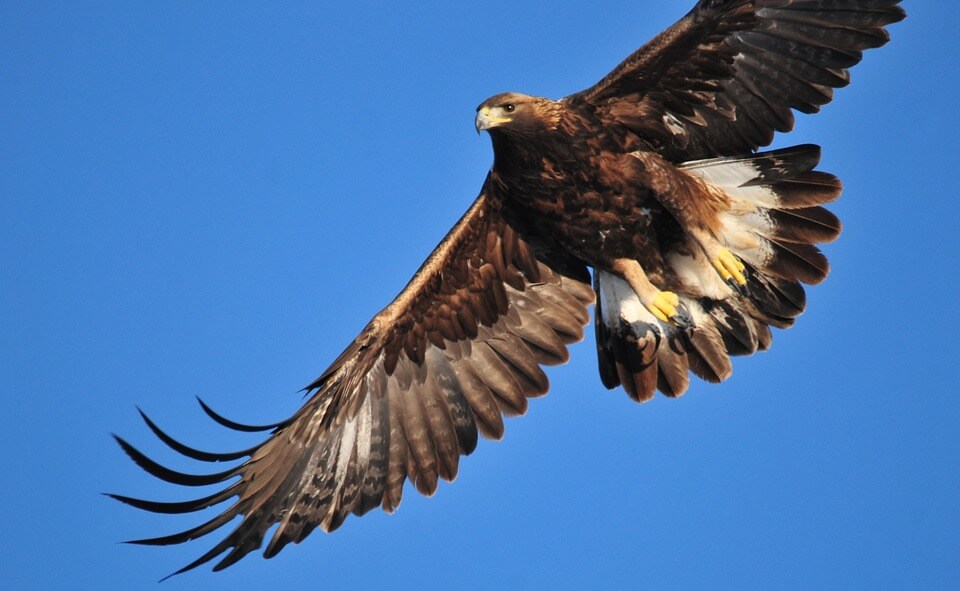Eagle Watching At Rogers Pass, 2008
by Russ Van Paepeghem
Broadcast 11.26 and 11.29.2019

Soaring Golden Eagle. Photo by Tom Koerner, USFWS.
Listen:
At 5,610 feet, in October, it’s cold. I have coffee waiting in a thermos and a stove to warm it or myself, if the wind blows too hard. I’m seated in the snow with a wool blanket over my legs, shielded from the wind by a fir whose lively scent overwhelms me. I check my watch: it’s been twenty minutes. I decide to hold out a bit for the coffee.
It’s 34 degrees here on Highway 200 at Rogers Pass, between Lincoln and Great Falls. A full moon in the pre-dawn haze asks me to pay attention, since the light it affords is dull and patchy. I hold a pair of binoculars in my gloved hands and sit waiting for the heavens to open, for all things avian to wrest from their roosts and take to the air. I wait for a bird made rare by the special status in our country of its bald cousin, for a bird made rare by its name: the Golden Eagle.
Since the late ’80s, studies in this region during spring migration find on average 1,100 goldens passing by. The birds travel northward towards breeding grounds, along the updrafts of the Rocky Mountain Front that allow for easier passage in northerly and southerly directions. As raptors at the top of their food chain, goldens are good indicators of the ecological health of a region. In recent years, studies show a population in decline. What does one do with this information? This is one of the questions of science, and of birders: what are we really looking at? I sit in the snow and wait for the sun to rise, and I decide that the coffee is now worth it.
The Latin name of the golden eagle is Aquila chrysaetos, which means, quite neatly in Latin, “eagle of gold.” For the Romans, the eagle was the bearer of the lightning of Jove, king of the gods. What did these ancient peoples observe of those angular and yet graceful wings? In flight, it is easy to understand the Roman narrative associated with this bird, since its average wingspan of six and a half feet outreaches the average man.
Researchers can safely say goldens of the region fly southeast to winter range in the fall and northwest in the spring, though not all will do this; if winter habitat is sufficient to sustain them, they’ll not migrate far or at all. But in the fall, some migrate as far south as west Texas and New Mexico. In the spring, some may fly as far north as Denali National Park, while others may stay along the Rocky Mountain trench in central British Columbia.
When the dull of the clouds concedes, light finally breaks onto the hillsides. The world opens. I hear crows hacking their way in the distance. I watch across the highway, which drums its own unique sound (in my hour spent here, I see seventy cars go over the pass). At 7:55, I see four outlines along the horizon. I try to bring them closer with the field glasses, and all I get is fainter outlines, as the dim light allows only an intimation of their real presence. Four birds, perhaps goldens.
I give up on the snow and the cold, and I drive toward home and stop in Lincoln. I walk around inside a store, and come back to my pickup. Then, the sure outline of a golden flies directly over my head, buzzing me, continuing out into the distance south of town. I know what I’ve seen. It beats its straight path into snowy clouds, which in the spring will bear sure bolts of lightning.
Every week since 1991, Field Notes has inquired about Montana’s natural history. Field Notes are written by naturalists, students, and listeners about the puzzle-tree bark, eagle talons, woolly aphids, and giant puffballs of Western, Central and Southwestern Montana and aired weekly on Montana Public Radio.
Click here to read and listen to more Field Notes. Field Notes is available as a podcast! Subscribe on iTunes, Google Play, or wherever you listen to podcasts.
Interested in writing a Field Note? Contact Allison De Jong, Field Notes editor, at adejong [at] montananaturalist [dot] org or 406.327.0405.
Want to learn more about our programs as well as fun natural history facts and seasonal phenology? Sign up for our e-newsletter! You can also become a member and get discounts on our programs as well as free reciprocal admission to 300+ science centers in North America!












